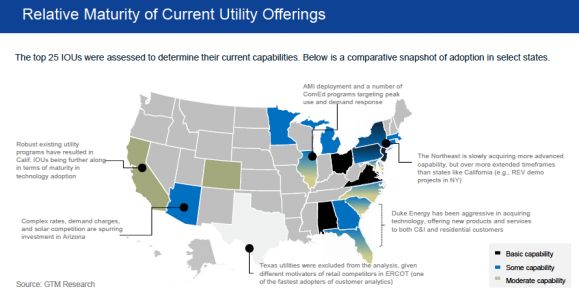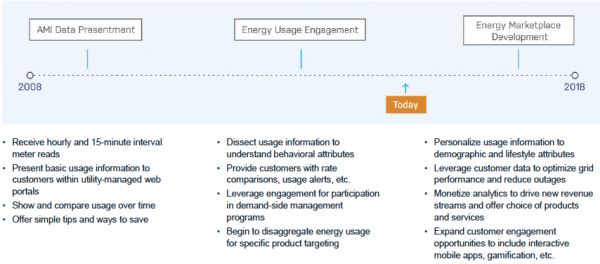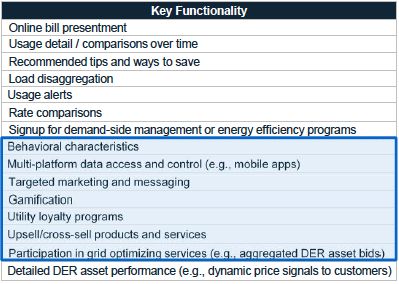U.S. utilities already spend billions of dollars on customer information system software, the workhorse platforms that run billing systems, call centers, and other customer-facing business operations. But there’s a new billion-dollar software opportunity lurking in the utility customer base, with new data and new communications channels to help solve distributed energy challenges on the edge of the grid.
Earlier this month, GTM Research released its report, Customer Analytics at the Grid Edge: Market Landscape, Forecast and Key Trends, which projects a major growth spurt for U.S. utility customer analytics investment, from less than $300 million this year to more than $1 billion by 2018. The report highlights more than a dozen companies in the space, from startups like Bidgely and Simple Energy to major-market contenders like Opower, EnerNOC, Tendril, Ecova and C3 Energy, as well as entrenched utility vendors like Oracle, SAP and Teradata.
The report also highlights the fact that big investor-owned utilities -- the country’s 25 biggest, to be specific -- are leading the way, with between $725 million and $1.1 billion in spending expected over the next 10 years. That’s largely because the big IOUs are the furthest ahead in pilot projects and business model trials, which gives them more data on costs and benefits to take to their state utility commissioners in support of larger-scale deployments.
And for these utility giants, the main driver for investment in the next two to four years will be the proliferation of distributed energy resources, the report finds. “Specifically, a focus on greater insight into the performance of customer generating assets (if they own them) or the ability to more easily engage customers in grid services and related value streams (e.g., peak load management) will drive a majority of large IOU investments in the coming years,” Steve Propper, GTM Research director and the report’s lead author, wrote.
Here’s a map that highlights utility developments in states like California, Arizona, New York and the Duke Energy-controlled Carolinas. (An important note: GTM Research did not examine Texas in this report, since its competitive market structure didn’t translate well for models built on investor-owned utilities in states with more traditional regulatory structures.)

“The focus for new technology development should remain on markets where regulators are actively seeking to animate customer-grid engagement,” Propper wrote. “These are the areas where utilities are likely to invest, and vendors can use these arenas as testing grounds for product innovation.”
The customer analytics that GTM Research is talking about aren't the same as the software of a few years ago. Usage alerts, rate comparisons, behavioral analytics, and the ability to connect customers with efficiency rebates, demand-response programs and other utility channels are taken for granted today. “Basic capabilities have either already been acquired by utilities, viewed as free or obvious add-ons to software buys, or are seen as insufficient on their own to begin leveraging customers as actual grid assets.”
The next wave of analytics will go further, into highly personalized data, “gamification” and other interactive ways to communicate via mobile devices, and the underlying measurement and verification (M&V) work required to turn the results of customer behavioral-based efficiency and demand management programs into dollars and cents. That’s all on top of the need for data to provide insight to grid operators and long-range planners, by the way.

GTM Research used public data and market information to price out its base case and high-end case for the top 25 U.S. utilities, representing about one-third of the country’s energy customers, using a “per-customer” measure to align with how many utilities file for cost recovery for these investments, as well as to allow the model to scale to the entire U.S. market.
It then categorized a set of capabilities that utilities are looking for, from basic to advanced. Most of the near-term spending will be for software with the moderate to advanced functionality, “specifically around behavior analytics, campaign management, target marketing and new engagement platforms (such as mobile).”

Each of the more than a dozen vendors profiled in the report is approaching this challenge from a slightly different stance, given their existing utility business. As a result, “There are numerous market players and many offerings look and feel the same,” Propper notes, suggesting “opportunities for greater market consolidation or partnership opportunities with non-traditional players” in the years ahead.



